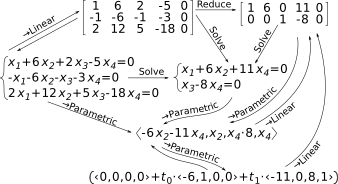3.6.7 Convert to Parametric
When a linear system has more than one solution, the solution set can be expressed as a tuple of equations, a vector of linear expressions or a linear surface (see §9.5.3). The tuple form is the result of linear conversion, described in §3.6.6 The vector and linear surface result from parametric conversion and participate in a cycle of transformations detailed in Figure 3.10
| Subject | Result |
| linear system | vector |
| matrix | vector |
| vector | linear surface |
| linear surface | vector |
- If the subject is a linear system, it is transformed into a parametric vector. Internally, the subject is transformed to a matrix and reduced. Variable names in the subject are preserved through the internal transformations and reproduced in the result.
- If the subject is a matrix of scalars, it is transformed into a vector of expressions whose variables are the free variables of the system.
- If the subject is a parametric vector it is transformed to a linear surface.
- If the subject is a linear surface, it is transformed to parametric vector.
- Conversion of either parametric form back to matrix form is accomplished by →Linear .
Linear conversion can be used in conjunction with parametric conversion, matrix reduction and Solve to achieve a variety of transformations. A map of conversion transformations is given in Figure 3.11

3.6.7.1 Convert to parametric vector
When converting a matrix to a parametric vector, each column in the unaugmented portion contributes a component. Columns for which there is no pivot element contribute a free variable. Columns with a pivot element contribute a linear combination of the other columns with suitable negations.
For example, the augmented matrix 






3.6.7.2 Convert to linear surface
A linear surface (§9.5.3)is a slightly different parametric representation of a vector
of linear expressions.
It is essentially a tuple of vectors in which the first element is treated as a point and the subsequent elements are
relative vectors, or attitudes.
Points on the surface are generated by applying a continuum of scalar multiples to the attitudes.
For example, the previous example converts to the linear surface 


When converting a linear surface to a parametric vector, the augmented matrix is recovered from the subject and converted as described above.